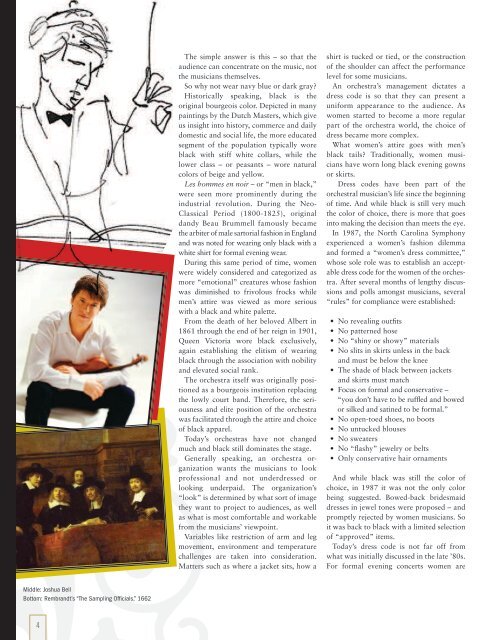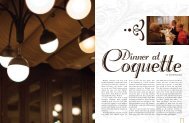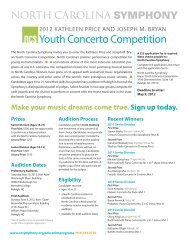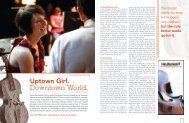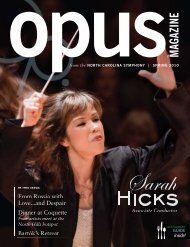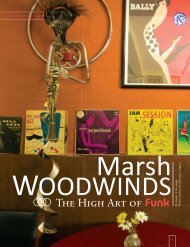Opus magazine - North Carolina Symphony
Opus magazine - North Carolina Symphony
Opus magazine - North Carolina Symphony
- No tags were found...
Create successful ePaper yourself
Turn your PDF publications into a flip-book with our unique Google optimized e-Paper software.
The simple answer is this – so that the<br />
audience can concentrate on the music, not<br />
the musicians themselves.<br />
So why not wear navy blue or dark gray<br />
Historically speaking, black is the<br />
original bourgeois color. Depicted in many<br />
paintings by the Dutch Masters, which give<br />
us insight into history, commerce and daily<br />
domestic and social life, the more educated<br />
segment of the population typically wore<br />
black with stiff white collars, while the<br />
lower class – or peasants – wore natural<br />
colors of beige and yellow.<br />
Les hommes en noir – or “men in black,”<br />
were seen more prominently during the<br />
industrial revolution. During the Neo-<br />
Classical Period (1800-1825), original<br />
dandy Beau Brummell famously became<br />
the arbiter of male sartorial fashion in England<br />
and was noted for wearing only black with a<br />
white shirt for formal evening wear.<br />
During this same period of time, women<br />
were widely considered and categorized as<br />
more “emotional” creatures whose fashion<br />
was diminished to frivolous frocks while<br />
men’s attire was viewed as more serious<br />
with a black and white palette.<br />
From the death of her beloved Albert in<br />
1861 through the end of her reign in 1901,<br />
Queen Victoria wore black exclusively,<br />
again establishing the elitism of wearing<br />
black through the association with nobility<br />
and elevated social rank.<br />
The orchestra itself was originally positioned<br />
as a bourgeois institution replacing<br />
the lowly court band. Therefore, the seriousness<br />
and elite position of the orchestra<br />
was facilitated through the attire and choice<br />
of black apparel.<br />
Today’s orchestras have not changed<br />
much and black still dominates the stage.<br />
Generally speaking, an orchestra organization<br />
wants the musicians to look<br />
professional and not underdressed or<br />
looking underpaid. The organization’s<br />
“look” is determined by what sort of image<br />
they want to project to audiences, as well<br />
as what is most comfortable and workable<br />
from the musicians’ viewpoint.<br />
Variables like restriction of arm and leg<br />
movement, environment and temperature<br />
challenges are taken into consideration.<br />
Matters such as where a jacket sits, how a<br />
shirt is tucked or tied, or the construction<br />
of the shoulder can affect the performance<br />
level for some musicians.<br />
An orchestra’s management dictates a<br />
dress code is so that they can present a<br />
uniform appearance to the audience. As<br />
women started to become a more regular<br />
part of the orchestra world, the choice of<br />
dress became more complex.<br />
What women’s attire goes with men’s<br />
black tails Traditionally, women musicians<br />
have worn long black evening gowns<br />
or skirts.<br />
Dress codes have been part of the<br />
orchestral musician’s life since the beginning<br />
of time. And while black is still very much<br />
the color of choice, there is more that goes<br />
into making the decision than meets the eye.<br />
In 1987, the <strong>North</strong> <strong>Carolina</strong> <strong>Symphony</strong><br />
experienced a women’s fashion dilemma<br />
and formed a “women’s dress committee,”<br />
whose sole role was to establish an acceptable<br />
dress code for the women of the orchestra.<br />
After several months of lengthy discussions<br />
and polls amongst musicians, several<br />
“rules” for compliance were established:<br />
• No revealing outfits<br />
• No patterned hose<br />
• No “shiny or showy” materials<br />
• No slits in skirts unless in the back<br />
and must be below the knee<br />
• The shade of black between jackets<br />
and skirts must match<br />
• Focus on formal and conservative –<br />
“you don’t have to be ruffled and bowed<br />
or silked and satined to be formal.”<br />
• No open-toed shoes, no boots<br />
• No untucked blouses<br />
• No sweaters<br />
• No “flashy” jewelry or belts<br />
• Only conservative hair ornaments<br />
And while black was still the color of<br />
choice, in 1987 it was not the only color<br />
being suggested. Bowed-back bridesmaid<br />
dresses in jewel tones were proposed – and<br />
promptly rejected by women musicians. So<br />
it was back to black with a limited selection<br />
of “approved” items.<br />
Today’s dress code is not far off from<br />
what was initially discussed in the late ’80s.<br />
For formal evening concerts women are<br />
black is the original<br />
bourgeois color<br />
still asked to wear something “comparable<br />
to and compatible with men’s tails outfit.”<br />
This is typically a black full-length dress or<br />
skirt, black full cut pants with a long or<br />
three-quarter length blouse or jacket. Black<br />
shoes and hose are required. (Navy blue<br />
has also been introduced to the current<br />
choice offerings)<br />
Some exceptions are made for both men<br />
and women – mostly surrounding holiday<br />
concert events.<br />
On New Year’s Eve women can wear a<br />
formal gown in their color of choice. For<br />
Holiday Pops shows men can pull out a<br />
festive cummerbund, vest or bow tie while<br />
women can wear a solid color representative<br />
of the holiday spirit.<br />
The summer allows both men and women<br />
to lighten up a little and wear white shorter<br />
sleeved shirts although black pants, skirts<br />
and shoes are still required. “No tank tops,<br />
casual pants or jeans” are allowed.<br />
Casual-ization<br />
While the orchestra world is still a fairly<br />
formal and conservative environment by<br />
most accounts, some organizations are<br />
trying to bring in new audiences by offering<br />
more “casual concerts” where the<br />
musicians wear blue jeans or perform in<br />
more casual clothes. This is designed to<br />
strip away the perceived elitism that may<br />
discourage attendance.<br />
Guest Artists<br />
While orchestras as a whole still strive to<br />
appear in uniform and in sync with each<br />
other, guest artists are more playful with<br />
their attire selections and have the freedom<br />
to “up” the flash factor for the audience.<br />
Violinist Joshua Bell typically appears in<br />
black slacks, a loose shirt and funky black<br />
shoes or boots. Pianist Lang Lang likes<br />
to wear colorful jackets, shirts and wild<br />
patterned pants. Violinist Nicolaj Znaider<br />
can be seen in a casual black turtleneck or<br />
dark suit with notable red lined jacket with<br />
an open-necked shirt and no tie.<br />
Some symphony goers still prefer a more<br />
traditional style of dress when attending<br />
concerts. And for the classical genre,<br />
that is certainly to be expected. But as<br />
orchestras broaden their repertoire to<br />
attract new audiences, a loosening of the<br />
old dress code rules is bound to be part of<br />
the proposition.<br />
No matter what a group of orchestra<br />
musicians are wearing, it’s about the<br />
music after all – and that makes everyone<br />
look beautiful.<br />
Middle: Joshua Bell<br />
Bottom: Rembrandt’s “The Sampling Officials,” 1662<br />
4<br />
5


